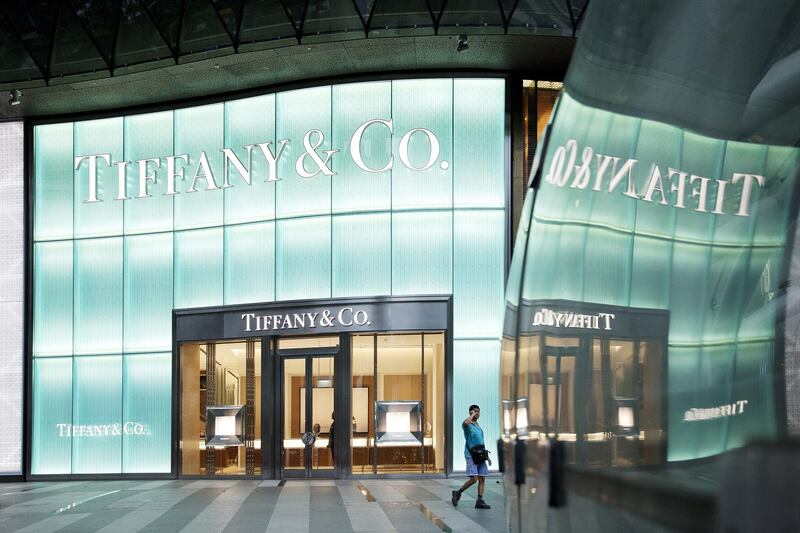US-based luxury jeweller Tiffany & Co, famed for its opulent diamonds, plans to open its first shops in India.
It is only fitting that Tiffany has partnered with Asia's richest man, Mukesh Ambani, through his conglomerate Reliance Industries as the jeweller plans to make its foray into India.
Despite an economic slowdown in the country, luxury brands are still seeing opportunities to tap Asia's third-largest economy, as wealth continues to rise and where there's a strong appetite for high-end names.
“India's the key market for luxury brands now as the western growth markets and their erstwhile growth market, China, have begun to stall,” says N Chandramouli, the chief executive of TRA Research, a consultancy based in Mumbai. “India is one of the few markets left to grow in their portfolio.”
He says that Tiffany is likely to “find favour with Indians as it carries brand vanity value”, although he adds that the competition is not necessarily good news for Indian luxury jewellery companies.
India's market for luxury goods was estimated by the Associated Chambers of Commerce and Industry of India (Assocham) to have reached $30 billion (Dh110.17bn) last year, up from $23.8bn the previous year. The industry group forecasts that the market is expected to increase five-fold over the next three years.
It cites the rise of travel, which is giving Indians more exposure to luxury brands, and expanding purchasing power as factors behind the trend. Assocham adds that relaxations to regulations in the retail industry by the government in recent years are making the Indian market even more attractive for international brands to enter the country.
Many luxury brands already have a strong foothold in the Indian market. For example, LVMH Moët Hennessy Louis Vuitton, the world’s biggest luxury goods company, has its Louis Vuitton stores in New Delhi, Mumbai and Bangalore. Brands including Armani, Burberry, Coach and Jimmy Choo line Mumbai's main luxury shopping mall.
“There's a want of consumerism of luxury spend in India,” says Gaurav Gupta, one of the country's leading fashion designers. “It's a lifestyle today in India and I think that lifestyle is because of social media, travel abroad, and it means that there's more aspiration in India. It's not only the main metros [metropolis cities] but even people from Indore, Lucknow, Raipur who can now shop for 500,000 rupees [Dh25,811] or 1 million rupees in one go.”
The economic backdrop in the country is not so glittering, though, and businesses targeting wealthy Indians say this has affected their sales.
The country's GDP growth in the first three months of the year slowed to a five-year low of 5.8 per cent, compared to 6.6 per cent in the previous quarter.
“If you talk about sales, everything is affected at the moment, including the luxury segment because luxury spending is a choice and it's non-essential, so you can always delay that choice,” says Jatin Ahuja, the founder of Big Boy Toyz, a luxury car dealer in Mumbai, which sells used cars including Lamborghinis, Maseratis, Roll Royces and Bentleys. His sales of luxury cars are down by about 15 to 20 per cent compared to a year ago.
Mr Ahuja says there are other challenges, such as high import duties, which make imported cars much more expensive in India than many other countries. Cars from abroad that cost more than $40,000 attract a customs duty of 100 per cent.
There is also a “luxury tax” in India, which, for example, means that five-star hotel stays are taxed at 28 per cent, the highest tax rate under the country's goods and services tax regime.
Relatively high tax rates in the country mean that many wealthy Indians prefer to shop in destinations including Dubai, the US and Europe.
But Mr Ahuja is upbeat about the longer term outlook for the market, which he says has enormous potential in a country that is highly aspirational.
“Indians have a great taste towards luxury, so we see a lot of brands coming in and when the brand comes and people physically see it, the demand picks up.”
And he points out that the luxury market has a rich history in India.
“All the kings and queens were buying Louis Vuitton 200 years ago,” says Mr Ahuja.
Luxury products are still out of reach of the majority of India's population, where 70.6 million people live in extreme poverty surviving on less than $1.90 a day, according to a report by the US research group Brookings Institution.
But at the top of the pyramid, people have more money in their hands, research shows.
India’s ultra high-net-worth population (those with wealth of over $30 million) increased by 24 per cent over the past five years, with 1,947 individuals falling into this category in India in 2018, according to a report released by Knight Frank in March. The growth in the number of ultra high-net-worth individuals in India last year over 2017, at 7 per cent, was well above the global average of 4 per cent and the average for the Asia region of 3 per cent.
“Emerging markets such as India and the Philippines will deliver some of the strongest growth over the coming years,” says Nicholas Holt, the head of research at Knight Frank Asia Pacific.
Swiss luxury watchmaker IWC says it has seen “phenomenal growth” in the Indian market. “We set up a subsidiary in Delhi several years ago and we anticipated the importance of the Indian market,” says Mehdi Rajan, IWC’s brand director for the Middle East, India and Africa.
Data reveals that while much of the focus of luxury brands has been on major cities such as Mumbai and New Delhi, which are home to many of the country's wealthy people, the growth of luxury spending in smaller “tier two” cities is on the rise. Luxury spend in second tier cities is growing at 30 times the rate of tier one cities, according to an American Express luxury spend analysis report for 2018, released earlier this year. The report also revealed that high-end fashion made up 42 per cent of the total luxury spend in India in 2018, while electronics and jewellery are other popular categories for big spenders.
This all bodes well for luxury brands such as Tiffany that are eager to tap India.
“As a global luxury jeweller with stores in many of the world’s most important cities, Tiffany’s emergence in these Indian commerce centres with their growing luxury consumer base presents a unique opportunity,” said Philippe Galtié, the executive vice-president of global sales for Tiffany & Co in a statement issued this month as it announced its India plans.
Its investment in India comes at a time when the global trade war is hurting luxury companies like Tiffany. The jeweller's international sales fell by 3 per cent in the quarter to April compared to a year earlier, while worries about higher Chinese tariffs in June prompted Tiffany to lower its earnings guidance.
That makes India an attractive prospect as the company looks to other markets to expand its business.
Mr Gupta points out, however, that infrastructure is a major challenge in India, given that not all cities have high streets. But more and more high-end shopping malls are coming up in the country, he adds, and that's going to create an enormous opportunity for luxury goods companies.
“I see in the next five years every metro and even tier two and tier three cities having luxury malls, so there will be a lot more infrastructure for all kinds of luxury brands to grow in India,” he says.







